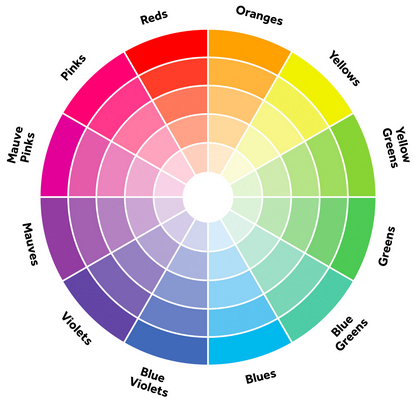Understanding Color
Before you choose colors and paint, it will help to have a basic understanding of the color wheel. The building blocks of the color wheel are the three primary colors: red, blue, and yellow. Secondary colors are the colors made by mixing only primary colors together. The tertiary colors are the colors made by mixing a primary color with a secondary color. Colors that are opposite of each other on the wheel are called complementary colors. Color harmony can be created in a number of ways. One popular way is to pair analogous colors, those found side by side on the color wheel, together. Complementary colors are another way to quickly achieve color harmony.
Pinpoint Your Color Style
Do you favor warm colors over cool, bold over neutral? Think about your favorite flower and glean some insight into your color style from it. Is it a bold yellow sunflower or a pale pink peony? Note its color, temperature, style, and overall feel. Do the same thinking about your favorite season of the year.
Make it work for YOUR home
Once you have mapped out your color style, it’s time to make it work in your space. What elements in your house do you want to highlight- the original wood floors or the art deco marble fireplace? Think about how the light falls in each room. You want to avoid painting a room deep brown if it gets no natural light (unless you like the dark dungeon feel). On the flipside, a living room that floods with natural light can handle a darker bold color choice without being overwhelmed. Once you have narrowed down your top paint choices, paint a patch of each on a wall in the intended room and observe how the light interacts with the different colors.
Connecting Rooms
Connecting rooms will vary in style and color, but should never clash with each other. Use colors that create harmony between adjoining rooms—and even bring a pop of unexpected contrast to the background. It is typical to paint all of the trim in your house the same color, a true or soft white. This keeps things consistent and lets your color choices shine through.
Wrightsville Sands: Tips for Traveling with Kids
Traveling with your children doesn’t have to be a nightmare. Plan, prepare, and arm yourself with these tips below for a pleasant vacation.
Book in Advance
Spontaneous trips are fun and romantic before children, but after children they are sheer chaos. Booking ahead ensures that you have a manageable schedule (flights that coincide with naptimes are ideal!) and that you can sit as a family on airplanes, busses, and trains! Advance planning will also ensure that you can secure your favorite beach rental before someone else snatches it up! When budget or time constraints mean flying or driving at times that are not ideal for you child’s schedule, refrain from giving them sugar since this will lead to sugar highs and compound the inevitable meltdowns.
Give them your Camera
Kids love snapping pictures and this will encourage them to engage with their new surroundings. For that matter, give them your phone or iPad if things get desperate. No shame in giving in to technology when it helps keep the kids pacified during long travel days. Plus, loading up your smart phone or tablet with apps is much easier than hauling around a bucket of toys to keep your kiddo entertained. Waterproof cases are recommended if you will be by a body of water like the ocean!
Bring Medicine
It never fails, children get sick on vacation. Their new surroundings, disrupted schedule, and lack of rest are all contributing factors. Make sure to have the usual suspects like cold medicine, pain and fever reducers, and allergy medicines. In addition, make sure to bring any prescription medicines for each family member in a clearly labeled Ziploc (always carry this with you on the plane so that you don’t run the risk of losing valuable and necessary meds). Bringing a first aid kit is also a great idea—you can customize it by including each kid’s favorite Band-Aids.
Prepare for the Climate
This means extra socks, layers, coats, and accessories for cold weather. And sunscreen, cover-ups, and light play clothes for a warmer climate. Nothing is worse than getting sunburnt on the first day of your beach vacation, so lather up and always start slow with sun exposure. Be sure to check the weather at your final destination the day before you leave—you want to be prepared even if a curve ball is thrown at you!
Baby Wipes are your Friend
Even if all of your children are out of diapers, baby wipes are a godsend for cleaning sticky hands and wiping down public services (think about that plane tray table that your toddler is bound to lick). Hand-sanitizer is also a travel essential and together these two will help keep illness at bay so that you can soak up the sunshine!
Take Public Transportation
Whenever possible, take the train, ferry, bus, or boat to your destination. Toddlers love the novelty of public transportation and are mesmerized by trains and boats. Of course, this means staying on high alert to make sure you don’t leave a kid on the tracks… Which brings us to the topic of tracking your kid. Decide if you want to invest in a child locator—normally a belt or strap worn by the child that will give off an alarm if you indicate they are lost. This can be a lifesaver in large crowds in a foreign country.
The tips are endless. Check out tourist pages for your destination to find out what kid-friendly activities are available. If you are staying at a vacation rental, reach out to the property manager to ask any questions you have for them relating to your family vacation experience. The most important step is to plan and set achievable expectations for the distance and time of your travels.
